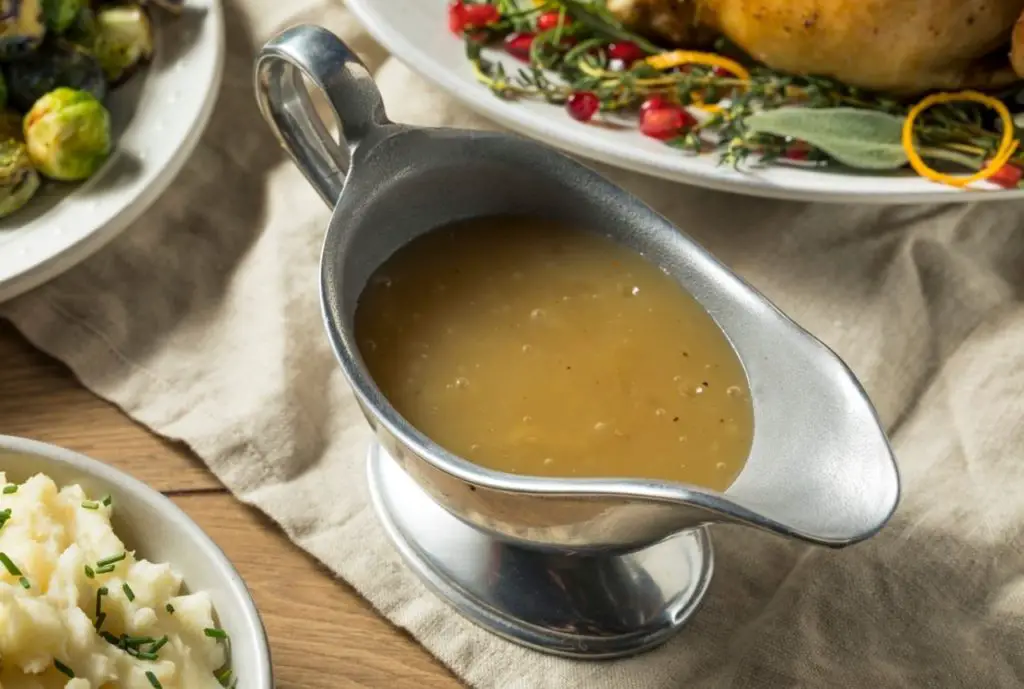There are so many dishes that just aren’t complete without gravy, but it is very easy to make much more than you need. If you don’t want your dinner to be drowning in gravy, what else can you do with it?
If you look at the ingredients, these tend to freeze well on their own: flour, milk, maybe some cream, and usually a stock of some sort. When combined, the shelf life rapidly shortens, unfortunately.

For example, if making your Sunday roast hasn’t gone very well (see also Freezing Yorkshire Pudding), and the gravy has been sitting out for more than an hour at room temperature, it’s not safe for consumption, and you’ll have to throw it.
While you can store it in the fridge once it has cooled, it will only keep for the best part of 2 days, maximum. So it makes sense, and it’s probably a relief that you can freeze it.
If you make the gravy with cream, it will keep for up to a week in the freezer. If you made the gravy from flour, this will last much longer in the freezer, up to about 4 months in total.
How Do You Freeze Gravy?
It is worth mentioning that gravy is at its best on the day that it’s made. After this, it will start to degrade, and that’s true no matter how you store it, even if you put it into the freezer.
So it is worth portioning it beforehand, so that you don’t defrost more than you need at any one time.
How To Prepare Gravy For The Freezer
It doesn’t matter if you are preparing leftovers or a fresh batch to freeze and use at a later date, the method is the same.
You’ll first need to boil the gravy for about 3 minutes before you try to freeze it. This will ensure there’s no lingering bacteria that could otherwise spoil the whole thing and render the freezing process useless.
If you’re going with leftovers, make sure that the gravy hasn’t been contaminated by other foods being dipped into it, to start with, otherwise you risk some cross contamination.
Leave the gravy to cool. Depending on how you want to portion the gravy, either grab some ice cube trays, airtight containers, or freezer bags which are suitable for liquids.
Decant the gravy into your choice of container, making sure to leave some space at the top for the gravy to expand as it freezes.

Make sure to seal each container well, and in the case of freezer bags, get rid of any excess air. Label as necessary, and then freeze.
How Do You Thaw Frozen Gravy And Reheat It?
The Best Way To Defrost Gravy
While defrosting gravy is a relatively simple process, you’ll still need to be careful how you do it. It’s better to do it gradually, as gravy is a very temperamental sauce which reacts to changes in temperature.
For this reason, it’s best to thaw gravy in the fridge overnight. Don’t be tempted to leave it on the counter to thaw, as this can make it unsafe to eat.
You’ll notice that once the gravy has fully thawed, there will be some separation, but this is easily fixed. Stir the gravy to reconstitute it.
How To Reheat Thawed Gravy
Once the gravy has fully defrosted, decant it into a saucepan of a suitable size and let it simmer on the hob for about 3 minutes at most.

If the gravy is too watery for your tastes, you can add some cornstarch to thicken it up a bit. When the gravy is piping hot and smooth, it’s ready.
Conclusion
Gravy is a staple of so many foods, but it is so easy to overestimate how much sauce you actually need to make.
As the amount of gravy can either make or ruin a dish, it’s extremely helpful that you can actually freeze it.
In some cases, it’s worth making a batch ahead of time, as you can then cut down on the cooking time later if you know you won’t have a spare ten minutes.
Just keep in mind that gravy can still perish in the freezer, so you will need to check that it is okay before serving it.

